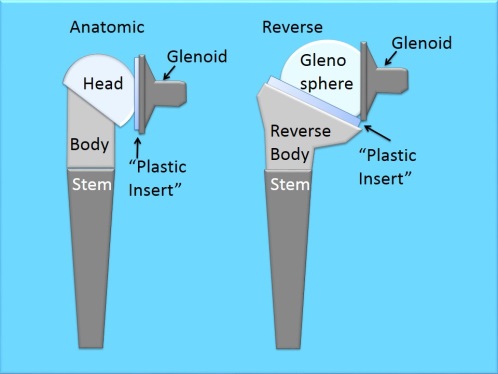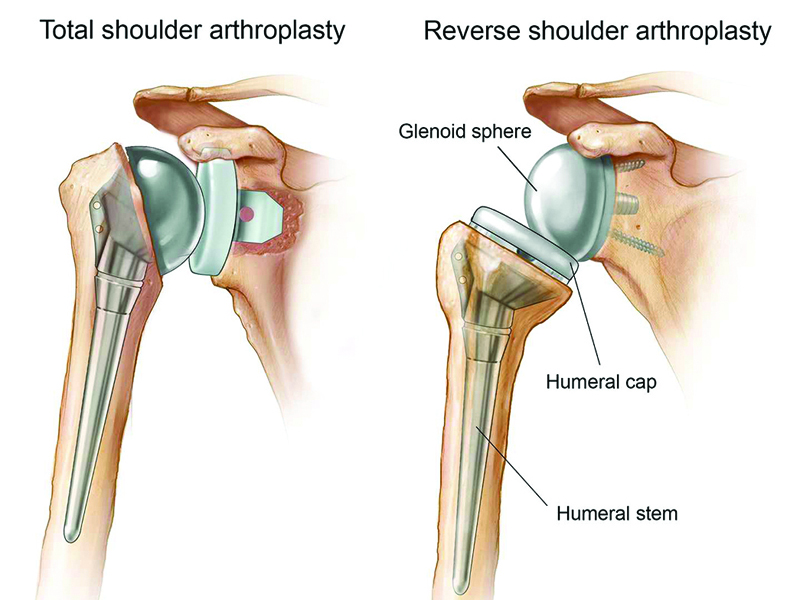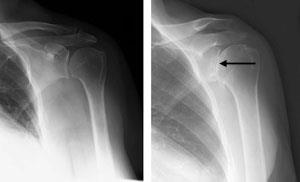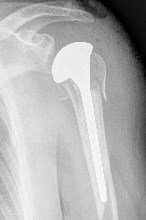- Home
- Dr Shailesh Keshav Mishra
- Arthroscopy
- Joint Replacement surgeries
- Arthritis care
- Type of Sports injuries
- Gallery
- Blogs
- Testimonials
- Contact Us
Total shoulder replacement also familiar as total shoulder arthroplasty is a very effectively successful surgical method for treating degenerative shoulder joint. The primary objective of the surgery is to give pain relief with a secondary support of restoring mobility of the shoulder, strength and its function. The surgery involves replacement of the humeral head (the joint ball) and the glenoid (the socket). The surgical procedure has been refined with prosthetic materials and improved rehabilitation techniques.
The two most common types of shoulder replacement are an anatomic shoulder replacement and a reverse total shoulder replacement. With an anatomic total shoulder replacement, the ball (humeral head) of the shoulder joint is replaced with an implant that includes a stem with a smooth, rounded metal head. The socket (glenoid) is replaced with a smooth, specialized plastic that is cemented into place. In essence the diseased cartilage is removed and resurfaced with the two components (Figure 2). In some cases just the ball is replaced, which is called a partial replacement or hemiarthroplasty. With a reversed total shoulder replacement, the normal structure of the shoulder is“reversed.” The ball portion of the implant isattached to the scapula (where the socketnormally is) and the artificial socket is attached to the humeral head (where the ball normally is) (Figure 3). This allows the stronger deltoid muscles of the shoulder to takeover much of the work of moving the shoulder, increasing joint stability. A reversed procedure is use for patients with a severely torn and compromised rotator cuff. It is also commonly used in revision surgery cases


Osteoarthritis, Degenerative shoulder pain is the most common symptom associated with progressive stiffness and loss of mobility for taking decision for shoulder replacement. A patient may sometime feel a grinding sensation in the shoulder joint. Osteoarthritis that cannot be controlled by conservative treatment management left the option for such operative method.

(Left) An x-ray of a healthy shoulder joint ,(Right)Osteoarthritis of the shoulder.
Note the decreased joint space (arrow).
A series of standard x-rays are obtained to assess the exact condition of the shoulder joint. Magnetic Resonance Imaging (MRI) and a CT scan may also be demanded by the surgeon to evaluate the quality of bone and surrounding muscles including rotator cuff tendon. EMG test that shows the possible nerve damage may also be required for assessment of nerve condition.
Joint replacement involves surgery to replace the ends of bones in a damaged joint. ... In shoulder replacement surgery, doctors replace the ends of the damaged upper arm bone (humerus) and usually the shoulder bone (scapula) or cap them with artificial surfaces lined with plastic or metal and plastic.
Depending on the condition of your shoulder, your surgeon may replace only the ball. This procedure is called a hemiarthroplasty. In a traditional hemiarthroplasty, the head of the humerus is replaced with a metal ball and stem, similar to the component used in a total shoulder replacement. This is called a stemmed hemiarthroplasty.Some surgeons recommend hemiarthroplasty when the humeral head is severely fractured but the socket is normal.

Shoulder Hemiarthroplasty
Other indications for a hemiarthroplasty include:
Sometimes, surgeons make the decision between a total shoulder replacement and a hemiarthroplasty in the operating room at the time of the surgery.
Studies show that patients with osteoarthritis get better pain relief from total shoulder arthroplasty than from hemiarthroplasty.
A surgeon will make sure about shoulder replacement surgery but before that, he will evaluate the following to prepare you for surgery:
After admission to the hospital you will be examined and evaluated by anesthetist and he will apply appropriate anesthesia for the surgery.
An incision will be made by your surgeon on the shoulder and replace the damaged bone and cartilage with a prosthetic implant made of metal and plastic. During the surgery, the ball is removed from the top of the arm bone, humerus and is replaced with an implant that shaped like a half moon which is attached to the stem inserted into the center of the arm bone. The socket is removed and replaced with a plastic socket and cemented with the shoulder blade or scapula. The entire procedure takes approximately two hours.
After the surgery, you will be kept in a recovery room. Medical staff will monitor your physical parameters like blood pressure, pulse, pain relief and swelling by providing ice-pack at your shoulder. When your anesthesia is completely worn off, you will be advised to fist your finger and hold for five seconds. This exercise will keep your blood circulation smooth. You will be prescribed medication, exercise and physical therapy to be continued at home. Make an appointment with the surgeon before leaving our hospital for review.
We assure the best affordable and less invasive and quick recoverable shoulder replacement surgical procedure.
You may use your arm to perform normal daily activities, such as eating, writing or shaving, but you may not lift any items or reach out suddenly until you are instructed that it is OK to do so. Six weeks after surgery, when you regain full shoulder movement, you can probably resume driving. This depends upon your rehabilitation progress.